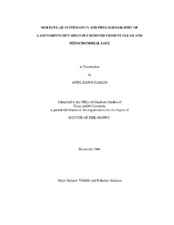| dc.contributor.advisor | Wursig, Bernd | |
| dc.contributor.advisor | Honeycutt, Rodney L. | |
| dc.creator | Harlin, April Dawn | |
| dc.date.accessioned | 2006-04-12T16:04:05Z | |
| dc.date.available | 2006-04-12T16:04:05Z | |
| dc.date.created | 2004-12 | |
| dc.date.issued | 2006-04-12 | |
| dc.identifier.uri | https://hdl.handle.net/1969.1/3186 | |
| dc.description.abstract | This study presents evidence from mitochondrial and nuclear loci that there is
genetic divergence among and within geographic populations of Lagenorhynchus
obscurus. The effect of seasonal variation on the genetic structure within New Zealand
was examined with mitochondrial DNA control region sequences from 4 localities.
Analysis of nested haplotype clades indicated genetic fragmentation and at least 1
historical population expansion within New Zealand. AMOVA and Fst values from
nuclear and mitochondrial DNA sequences suggested significant divergence between
New Zealand, South Africa, Argentina, and Peru. Dispersal via the west-wind drift was
not supported by patterns of population structure among regions. Alternatively, these
data support reciprocal exchange among all four regions with 100% posterior probability
for a root of origin in the Indian/Atlantic Oceans. The degree of divergence between
Peru and other regions indicates the isolation of Peruvian stock is temporally correlated
with the constriction of DrakeÂ’s passage in the Plio-Pleistocene. There is evidence that
the Plio-Pliestocene paleoceanography of the Indian and Southern Atlantic Oceans
influenced phylogeography with shifts of temperate sea surface temperatures northward
~5º of latitude, disrupting the dispersal corridor between New Zealand and Atlantic
populations. A preference for temperate waters along continental shelves is proposed as
an explanation for lack of contemporary genetic exchange among regions. This study
supports the polyphyly of the genus Lagenorhynchus. North Atlantic species form a
monophyletic Lagenorhynchus. In the Southern Hemisphere, L. australis/L. cruciger
and L. obliquidens/L. obscurus do not form a monophyletic group. I discuss the
taxonomic implications and propose taxonomic revision of the genus based on these
results. Measures of character interaction indicate that combined evidence from nuclear
and mitochondrial genes provide better phylogenetic resolution among delphinid
lineages than any data partition independently, despite some indications of conflict
among mitochondrial and nuclear data. | en |
| dc.format.extent | 8961233 bytes | en |
| dc.format.medium | electronic | en |
| dc.format.mimetype | application/pdf | |
| dc.language.iso | en_US | |
| dc.publisher | Texas A&M University | |
| dc.subject | nuclear gene phylogeography | en |
| dc.subject | dolphin systematics | en |
| dc.subject | data interaction | en |
| dc.subject | population structure | en |
| dc.subject | dusky dolphin | en |
| dc.subject | Lagenorhynchus obscurus | en |
| dc.subject | west-wind drift | en |
| dc.title | Molecular systematics and phylogeography of the dusky dolphin (Lagenorhynchus obscurus) derived from nuclear and mitochondrial loci | en |
| dc.type | Book | en |
| dc.type | Thesis | en |
| thesis.degree.department | Wildlife and Fisheries Sciences | en |
| thesis.degree.discipline | Wildlife and Fisheries Sciences | en |
| thesis.degree.grantor | Texas A&M University | en |
| thesis.degree.name | Doctor of Philosophy | en |
| thesis.degree.level | Doctoral | en |
| dc.contributor.committeeMember | Woolley, Jim | |
| dc.contributor.committeeMember | Fitzgerald, Lee | |
| dc.type.genre | Electronic Dissertation | en |
| dc.type.material | text | en |
| dc.format.digitalOrigin | born digital | en |


